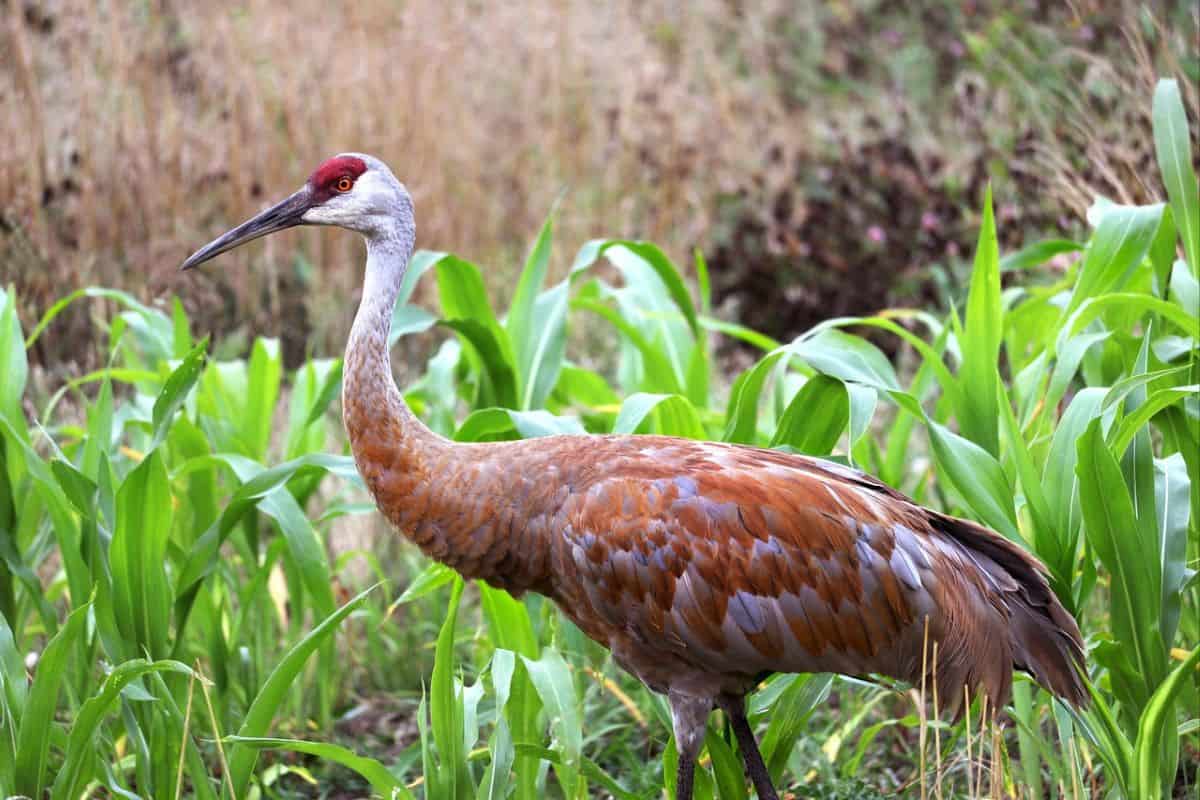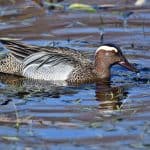Common Name: Sandhill Crane
Scientific Name: Antigone canadensis| Size | Diet | Range in Hawaii | Status in Hawaii |
|---|---|---|---|
| 36 in. - 54 in. | seeds, grains, berries, and tubers | Oahu | Least Concern |
The Sandhill Crane (Antigone canadensis) is a magnificent bird species that is widely distributed throughout North America and Siberia. These large, elegant birds are known for their distinctive calls and striking appearance, with gray plumage and a red forehead patch.
While the Sandhill Crane is not native to Hawaii, it is a popular migratory species that can be seen in the state during the winter months. In this article, we will explore the fascinating world of the Sandhill Crane, including its biology, behavior, and habitat. We will also take a closer look at the Sandhill Crane’s presence in Hawaii and the conservation efforts being made to protect this species and its habitat.
Sandhill Crane
Appearance
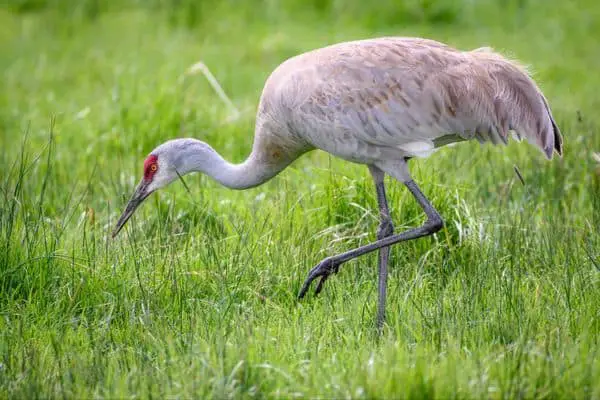
The Sandhill Crane is a majestic bird known for its distinctive appearance. Standing at a height of 36 to 54 inches (91 to 137 centimeters) and boasting an impressive wingspan of 60 to 84 inches (152 to 213 centimeters), this crane species captivates with its long neck and legs. Its grayish-brown plumage covers its large frame, complemented by a striking red crown atop its head and a long, pointed bill.
Diet
The Sandhill Crane has a diverse and omnivorous diet. It primarily feeds on plant matter, including seeds, grains, berries, and tubers. It also consumes insects, small mammals, amphibians, reptiles, and occasionally small birds.
Sandhill Cranes use their long bills to probe and forage in wetland areas, fields, and grasslands, where they find their food sources. Their adaptable feeding habits allow them to thrive in various habitats and make use of available resources.
Nesting
Sandhill Cranes (Antigone canadensis) exhibit complex nesting behaviors. They typically form monogamous pairs and construct large nests on the ground, often in wetland areas or marshy habitats.
The nests are built using surrounding vegetation and are lined with grasses and other materials. Both the male and female contribute to nest building.
Sandhill Cranes lay one to three eggs, with an average clutch size of two. The eggs are incubated primarily by the female for about 28 to 32 days.
After hatching, both parents care for and protect the chicks, which are precocial and can walk and feed themselves shortly after hatching. The parents guide and teach the young cranes how to forage for food and navigate their environment.
Nesting for Sandhill Cranes is an important part of their breeding cycle, and they invest significant effort in creating a safe and suitable environment for their offspring. Successful nesting is crucial for the continuation of their species.
Behavior
Sandhill Cranes exhibit fascinating nesting behaviors as part of their breeding cycle. They form monogamous pairs and engage in elaborate courtship displays, which involve dancing, calling, and various body movements. These displays strengthen the bond between the pair and establish territory.
Once a suitable mate is chosen, Sandhill Cranes build large nest structures on the ground, typically in wetland areas or marshy habitats. The nests are constructed using plant materials such as grasses, reeds, and sedges. Both the male and female contribute to the nest building process, with the male gathering materials and the female arranging them.
The female then lays one to three eggs, and both parents take turns incubating them for about 28 to 32 days. During this period, the parents diligently rotate shifts to ensure the eggs are properly warmed and protected. Once the eggs hatch, the parents continue to share responsibilities in raising and caring for the chicks.
Habitat
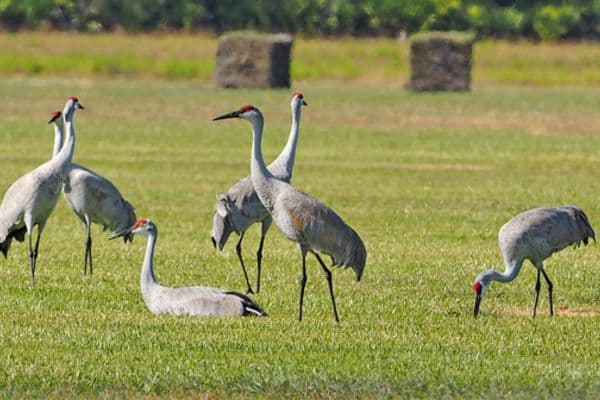
Sandhill Cranes choose specific habitats for nesting that provide the necessary conditions for successful reproduction. They prefer wetland areas, such as marshes, bogs, and prairie potholes, as their primary nesting habitat. These habitats offer a combination of open water, emergent vegetation, and nearby upland areas.
The presence of wetlands provides Sandhill Cranes with access to abundant food sources, such as aquatic plants, invertebrates, and small vertebrates. The wetland vegetation also offers nesting materials for constructing their nests. Additionally, the open nature of these habitats allows for better visibility, enabling the cranes to detect potential threats and predators.
Sandhill Cranes also select nesting sites in upland areas adjacent to wetlands, which provide suitable foraging grounds and a higher vantage point for surveillance. These upland areas typically consist of grasslands, agricultural fields, or prairies.
Range
The Sandhill Crane is a migratory bird species that is not native to Hawaii, but is a rare visitor to the state during the winter months. These birds can be spotted in wetland areas including Oahu where they have been observed. However, their exact range within Hawaii is not well-documented, and there is limited evidence to suggest that the Sandhill Crane is a common species on any of the Hawaiian islands.
Conservation Status
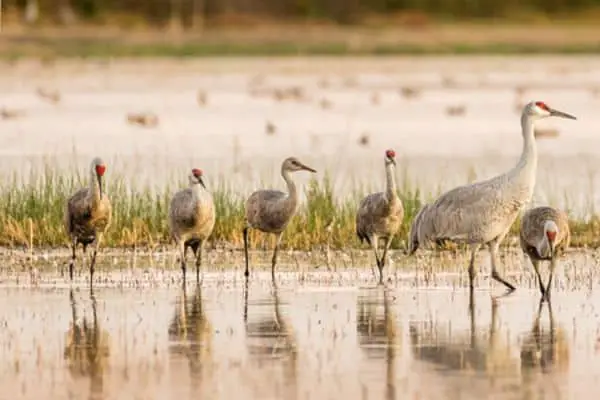
The Sandhill Crane is indeed listed as “Least Concern” by the International Union for Conservation of Nature (IUCN). This designation indicates that the species is not currently facing significant threats to its survival and has a stable population size.
The Sandhill Crane’s large and widespread distribution, along with its adaptable nature and ability to thrive in a variety of habitats, contribute to its least concern status. However, it’s important to note that local populations or subspecies may face more specific conservation concerns depending on their geographical location and habitat conditions.
Interesting Facts
1. Impressive size
The impressive size of the Sandhill Crane contributes to its awe-inspiring presence. Standing between 3 and 5 feet tall (91 to 152 cm), these cranes tower over many other bird species in North America. Their long legs and necks, coupled with a slender yet robust body, give them a majestic appearance.
2. Impressive migrations
Sandhill Cranes exhibit remarkable flying abilities, covering astonishing distances of up to 400 miles in a single day.
3. Lifelong monogamy
Sandhill Cranes are monogamous birds, often forming lifelong pair bonds. They mate for life, and both parents actively participate in nest-building, incubation, and raising their chicks.
4. Complex courtship dances
During courtship displays, Sandhill Cranes engage in elaborate dances that involve leaping, wing-flapping, and bowing. These displays not only strengthen pair bonds but also attract mates.
5.Unique Vocalizations
These cranes are famous for their distinctive calls, which can be heard over long distances. Their bugling calls range from loud, trumpeting sounds to softer, rolling rattles.
Frequently Asked Questions
1. How long do Sandhill Cranes live?
Sandhill Cranes have an average lifespan of 20 to 30 years in the wild. However, some individuals have been known to live up to 40 years or more.
2. How do Sandhill Cranes communicate?
Sandhill Cranes are known for their distinctive vocalizations, which include bugling calls. They use various calls and body movements to communicate with each other, expressing aggression, courtship, or warning signals.
3. Are Sandhill Cranes protected by law?
Yes, Sandhill Cranes are protected under various laws and regulations in many countries. These protections help conserve their populations and regulate hunting practices.
4. Can Sandhill Cranes swim?
Sandhill Cranes are not strong swimmers, but they can wade in shallow water. They primarily forage on land and in shallower wetland areas.
5. Can Sandhill Cranes be kept as pets?
No, it is generally illegal to keep Sandhill Cranes as pets. They are protected under various wildlife conservation laws, and it is important to respect their natural habitats and behaviors.
